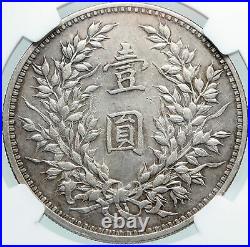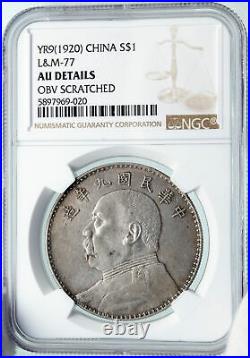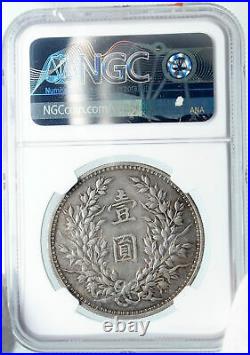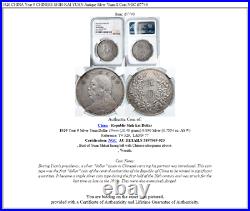





Item: i87740 Authentic Coin of. Republic Shih-kai Dollar 1920 Year 9 Silver Yuan Dollar 39mm (26.40 grams) 0.890 Silver 0.7554 oz. ASW Reference: Y# 329, L&M# 77 Certification: NGC. AU DETAILS 5897969-020 , Bust of Yuan Shikai facing left with Chinese ideograms above. Coin Notes: During Yuan’s presidency, a silver “dollar” (yuan in Chinese) carrying his portrait was introduced. This coin type was the first “dollar” coin of the central authorities of the Republic of China to be minted in significant quantities. It became a staple silver coin type during the first half of the 20th century and was struck for the last time as late as the 1950s. They were also extensively forged. He tried to save the dynasty with a number of modernization projects including bureaucratic, fiscal, judicial, educational, and other reforms, despite playing a key part in the failure of the Hundred Days’ Reform. He established the first modern army and a more efficient provincial government in North China in the last years of the Qing dynasty before the abdication of the Xuantong Emperor, the last monarch of the Qing dynasty, in 1912. Through negotiation, he became the first President of the Republic of China in 1912. This army and bureaucratic control were the foundation of his autocratic. He was frustrated in a short-lived attempt to restore hereditary monarchy in China, with himself as the Hongxian Emperor (Chinese:). His death shortly after his abdication led to the fragmentation of the Chinese political system and the end of the Beiyang government as China’s central authority. Years in Joseon Dynasty Korea. In the early 1870s, Korea under the Joseon dynasty was in the midst of a struggle between isolationists under King Gojong’s father Heungseon Daewongun, and progressives, led by Empress Myeongseong, who wanted to open trade. After the Meiji Restoration, Japan had adopted an aggressive foreign policy, contesting Chinese domination of the peninsula. Under the Treaty of Ganghwa, which the Koreans signed with reluctance in 1876, Japan was allowed to send diplomatic missions to Hanseong, and opened trading posts in Incheon and Wonsan. Amidst an internal power struggle which resulted in the queen’s exile, the Viceroy of Zhili, Li Hongzhang, sent the 3,000 strong Qing Brigade into Korea. The Korean king proposed training 500 troops in the art of modern warfare, and Yuan Shikai was appointed to lead this task in Korea. Li Hongzhang also recommended Yuan’s promotion, with Yuan given the rank of sub-prefect. In 1885, Yuan was appointed Imperial Resident of Seoul. On the surface the position equalled that of ambassador but in practice, as head official from the suzerain, Yuan had become the supreme adviser on all Korean government policies. Perceiving China’s increasing influence on the Korean government, Japan sought more influence through co-suzerainty with China. A series of documents were released to Yuan Shikai, claiming the Korean government had changed its stance towards Chinese protection and would rather turn to Russia for protection. Yuan was outraged yet skeptical and asked Li Hongzhang for advice. In a treaty signed between Japan and Qing, the two parties agreed only to send troops into Korea after notifying the other. Although the Korean government was stable, it was still a protectorate of Qing. Koreans emerged advocating modernization. Another more radicalised group, the Donghak Society, promoting an early nationalist doctrine based partly upon Confucian principles, rose in rebellion against the government. Yuan and Li Hongzhang sent troops into Korea to protect Seoul and Qing’s interests, and Japan did the same under the pretext of protecting Japanese trading posts. Tensions boiled over between Japan and China when Japan refused to withdraw its forces and placed a blockade at the 38th Parallel. Li Hongzhang wanted at all costs to avoid a war with Japan and attempted this by asking for international pressure for a Japanese withdrawal. Japan refused, and war broke out. Yuan, having been put in an ineffective position, was recalled to Tianjin in July 1894, before the official outbreak of the First Sino-Japanese War. Yuan Shikai had three Korean concubines, one of whom was Korean Princess Li’s relative, concubine Kim. 15 of Yuan’s children came from these three Korean women. The Empress Dowager and the Guangxu Emperor died within a day of each other in November 1908. Sources indicate that the will of the emperor ordered Yuan’s execution. Nonetheless, he avoided death. In January 1909, he was relieved of all his posts by the regent, Prince Chun. The public reason for Yuan’s resignation was that he was returning to his home in the village of Huanshang , the prefecture-level city of Anyang, due to a foot disease. During his three years of effective exile, Yuan kept contact with his close allies, including Duan Qirui, who reported to him regularly about army proceedings. Yuan had arranged for the marriage of his niece (whom he had adopted) to Duan as a means to consolidate power. The loyalty of the Beiyang Army was still undoubtedly behind him. Having this strategic military support, Yuan held the balance of power between various revolutionaries (like Sun Yat-sen) and the Qing court. Both wanted Yuan on their side. Wuchang Uprising and republic. The Wuchang Uprising took place on 10 October 1911 in Hubei province. The southern provinces subsequently declared their independence from the Qing court, but neither the northern provinces nor the Beiyang Army had a clear stance for or against the rebellion. Both the Qing court and Yuan were fully aware that the Beiyang Army was the only Qing force powerful enough to quell the revolutionaries. The court requested Yuan’s return on 27 October, but he repeatedly declined offers from the Qing court for his return, first as the Viceroy of Huguang, and then as Prime Minister of the Imperial Cabinet. Time was on Yuan’s side, and Yuan waited, using his “foot ailment” as a pretext to his continual refusal. After further pleas by the Qing Court, Yuan agreed and eventually left his village for Beijing on 30 October, becoming Prime Minister on 1 November 1911. Immediately after that he asked the Regent to withdraw from politics, which forced Zaifeng to resign as regent. This made way for Yuan to form a new, predominantly Han Chinese, cabinet of confidants, with only one Manchu as Minister of Suzerainty. To further reward Yuan’s loyalty to the court, the Empress Dowager Longyu offered Yuan the noble title Marquis of the First Rank , an honour only previously given to 19th century General Zeng Guofan for his raising of the Xiang Army to suppress the Taiping Rebellion. Meanwhile, in the Battle of Yangxia, Yuan’s forces recaptured Hankou and Hanyang from the revolutionaries. Yuan knew that complete suppression of the revolution would end his usefulness to the Qing regime. Instead of attacking Wuchang, he began to negotiate with the revolutionaries. Becoming emperor Republic of China. Tensions between the KMT and Yuan continued to intensify. After arriving in Peking, the elected Parliament attempted to gain control over Yuan, to develop a permanent constitution, and to hold a legitimate, open presidential election. Yuan’s crackdown on the KMT began in 1913, with the suppression and bribery of KMT members in the two legislative chambers. Anti-Yuan revolutionaries also claimed Yuan orchestrated the collapse of the KMT internally and dismissed governors interpreted as being pro-KMT. Seeing the situation for his party worsen, Sun Yat-sen fled to Japan in August 1913, and called for a Second Revolution, this time against Yuan Shikai. Subsequently, Yuan gradually took over the government, using the military as the base of his power. He dissolved the national and provincial assemblies, and the House of Representatives and Senate were replaced by the newly formed “Council of State”, with Duan Qirui, his trusted Beiyang lieutenant, as Prime Minister. He relied on the American-educated Tsai Tingkan for English translation and connections with western powers. Finally, Yuan had himself elected president to a five-year term, publicly labelled the KMT a seditious organization, ordered the KMT’s dissolution, and evicted all its members from Parliament. The KMT’s “Second Revolution” ended in failure as Yuan’s troops achieved complete victory over revolutionary uprisings. Provincial governors with KMT loyalties who remained willingly submitted to Yuan. Because those commanders not loyal to Yuan were effectively removed from power, the Second Revolution cemented Yuan’s power. In January 1914, China’s Parliament was formally dissolved. To give his government a semblance of legitimacy, Yuan convened a body of 66 men from his cabinet who, on 1 May 1914, produced a “constitutional compact” that effectively replaced China’s provisional constitution. The new legal status quo gave Yuan, as president, practically unlimited powers over China’s military, finances, foreign policy, and the rights of China’s citizens. Yuan justified these reforms by stating that representative democracy had been proven inefficient by political infighting. After his victory, Yuan reorganized the provincial governments. Each province was supported by a military governor as well as a civil authority, giving each governor control of their own army. This helped lay the foundations for the warlordism that crippled China over the next two decades. During Yuan’s presidency, a silver “dollar” (yuan in Chinese) carrying his portrait was introduced. To build up his own authority, Yuan began to re-institute elements of state Confucianism. As the main proponent of reviving Qing state religious observances, Yuan effectively participated as emperor in rituals held at the Qing Temple of Heaven. In late 1915, rumors were floated of a popular consensus that the hereditary monarchy should be revived. With his power secure, many of Yuan’s supporters, notably monarchist Yang Du, advocated for a revival of the hereditary monarchy, asking Yuan to take on the title of Emperor. Yang reasoned that the Chinese masses had long been used to monarchic rule, the Republic had only been effective as a transitional phase to end Manchu rule, and China’s political situation demanded the stability that only a dynastic monarchy could ensure. The American political scientist Frank Johnson Goodnow suggested a similar idea. Negotiators representing Japan had also offered to support Yuan’s ambitions as one of the rewards for Yuan’s support of the Twenty-One Demands. On 20 November 1915, Yuan held a specially convened “Representative Assembly” which voted unanimously to offer Yuan the throne. On 12 December 1915, Yuan “accepted” the invitation and proclaimed himself Emperor of the Chinese Empire (simplified Chinese: ; traditional Chinese: ; pinyin: Zhnghuá Dìguó Dà Huángdì) under the era name of Hongxian simplified Chinese: ; traditional Chinese: ; pinyin: Hóngxiàn ; i. The new Empire of China was to formally begin on 1 January 1916, when Yuan, the Hongxian Emperor, intended to conduct the accession rites. Soon after becoming emperor, the Hongxian Emperor placed an order with the former imperial potters for a 40,000-piece porcelain set costing 1.4 million yuan, a large jade seal, and two imperial robes costing 400,000 yuan each. Abandonment of monarchy and death. Faced with widespread opposition, the Hongxian Emperor repeatedly delayed the accession rites in order to appease his foes, but his prestige was irreparably damaged and province after province continued to voice disapproval. On 25 December 1915, Yunnan’s military governor, Cai E, rebelled, launching the National Protection War. The governor of Guizhou followed in January 1916, and Guangxi declared independence in March. Funding for the Hongxian Emperor’s accession ceremony was cut on 1 March. Yuan formally abandoned the empire on 22 March after being emperor for only 83 days; primarily due to these mounting revolts as well as declining health from uremia. This was not enough for his enemies, who called for his resignation as president, causing more provinces to rebel. Yuan died of uremia at 10 a. On 6 June 1916, at the age of fifty-six. Yuan’s remains were moved to his home province and placed in a large mausoleum. In 1928, the tomb was looted by Feng Yuxiang and his soldiers during the Northern Expedition. Yuan had a wife and nine concubines, who bore him 17 sons, but only three were prominent: Prince Yuan Keding, Prince Yuan Kewen, and Prince Yuan Keliang. Historians in China have considered Yuan’s rule mostly negatively. He introduced far-ranging modernizations in law and social areas, and trained and organized one of China’s first modern armies. But the loyalty Yuan had fostered in the armed forces dissolved after his death, undermining the authority of the central government. Yuan financed his regime through large foreign loans, and is criticized for weakening Chinese morale and international prestige, and for allowing the Japanese to gain broad concessions over China. Jonathan Spence, however, notes in his influential survey that Yuan was “ambitious, both for his country and for himself”, and that even as he subverted the constitution, paradoxically he sought to build on late-Qing attempts at reforms and to develop institutions that would bring strong and stable government to China. To gain foreign confidence and end the hated system of extraterritoriality, Yuan strengthened the court system and invited foreign advisers to reform the penal system. After Yuan’s death, there was an effort by Li Yuanhong to revive the Republic by recalling the legislators who had been ejected in 1913, but this effort was confused and ineffective in asserting central control. Li lacked any support from the military. There was a short-lived effort in 1917 to revive the Qing dynasty led by the loyalist general Zhang Xun, but his forces were defeated by rival warlords later that year. After the collapse of Zhang’s movement, all pretense of strength from the central government collapsed, and China descended into a period of warlordism. Over the next several decades, the offices of both the president and parliament became the tools of militarists, and the politicians in Peking became dependent on regional governors for their support and political survival. For this reason, Yuan is sometimes called “the Father of the Warlords”. However, it is not accurate to attribute China’s subsequent age of warlordism as a personal preference, since in his career as a military reformer he had attempted to forge a modern army based on the Japanese model. Throughout his lifetime, he demonstrated an understanding of staffing, military education, and regular transfers of officer personnel, combining these skills to create China’s first modern military organisation. After his return to power in 1911, however, he seemed willing to sacrifice his legacy of military reform for imperial ambitions, and instead ruled by a combination of violence and bribery that destroyed the idealism of the early Republican movement. In the CCTV Production Towards the Republic , Yuan is portrayed through most of his early years as an able administrator, although a very skilled manipulator of political situations. His self-proclamation as Emperor is largely depicted as being influenced by external forces, especially that of his son, prince Yuan Keding. A bixi (stone tortoise) with a stele in honor of Yuan Shikai, which was installed in Anyang’s Huanyuan Park soon after his death, was (partly) restored in 1993. World-renowned expert numismatist, enthusiast, author and dealer in authentic ancient Greek, ancient Roman, ancient Byzantine, world coins & more. Ilya Zlobin is an independent individual who has a passion for coin collecting, research and understanding the importance of the historical context and significance all coins and objects represent. Send me a message about this and I can update your invoice should you want this method. Getting your order to you, quickly and securely is a top priority and is taken seriously here. Great care is taken in packaging and mailing every item securely and quickly. What is a certificate of authenticity and what guarantees do you give that the item is authentic? You will be very happy with what you get with the COA; a professional presentation of the coin, with all of the relevant information and a picture of the coin you saw in the listing. Additionally, the coin is inside it’s own protective coin flip (holder), with a 2×2 inch description of the coin matching the individual number on the COA. Whether your goal is to collect or give the item as a gift, coins presented like this could be more prized and valued higher than items that were not given such care and attention to. When should I leave feedback? Please don’t leave any negative feedbacks, as it happens sometimes that people rush to leave feedback before letting sufficient time for their order to arrive. The matter of fact is that any issues can be resolved, as reputation is most important to me. My goal is to provide superior products and quality of service. How and where do I learn more about collecting ancient coins? Visit the Guide on How to Use My Store. For on an overview about using my store, with additional information and links to all other parts of my store which may include educational information on topics you are looking for. The item “1920 CHINA Year 9 CHINESE SHIH-KAI YUAN Antique Silver Yuan-$ Coin NGC i87740″ is in sale since Thursday, May 6, 2021. This item is in the category “Coins & Paper Money\Coins\ World\Asia\China\Empire (up to 1948)”. The seller is “highrating_lowprice” and is located in Rego Park, New York. This item can be shipped worldwide.
- Country/Region of Manufacture: China
- Certification Number: 5897969-020
- Certification: NGC
- Grade: AU DETAILS
- Year: 1920
- Composition: Silver
- Denomination: Yuan

